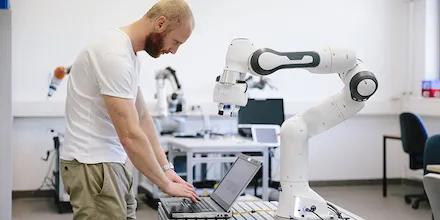Introduction
Robotic arms have become indispensable in hazardous environments such as nuclear facilities, oil & gas installations, and mining operations. These environments pose significant risks to human workers due to radiation exposure, toxic gases, high temperatures, and unstable terrains. Robotic arms equipped with advanced sensors, control systems, and specialized tools are revolutionizing these industries by performing critical tasks while keeping human workers safe.
In nuclear facilities, robotic arms are used for tasks such as inspection, maintenance, and handling of radioactive materials. They can navigate through complex and highly radioactive areas, reducing the risk of radiation exposure for human workers. Robotic arms equipped with cameras and sensors can detect leaks, cracks, and other defects in nuclear reactors, allowing for timely repairs and preventing potential disasters.
In oil & gas installations, robotic arms are employed for inspection, maintenance, and repairs. They can inspect pipelines, valves, and equipment, identifying corrosion, leaks, and other defects. By performing routine maintenance tasks, robotic arms reduce the need for human workers to work in dangerous conditions, improving worker safety and operational efficiency.
In mining operations, robotic arms are transforming exploration, extraction, and maintenance tasks. They can explore underground mines, collect data for mapping and planning purposes, and perform drilling and blasting operations. Robotic arms also contribute to improved efficiency and productivity in mining operations, as they can operate continuously without the need for breaks or shifts.
Throughout this blog, we will delve into the various applications and benefits of robotic arms in these industries. We will explore how these machines enhance worker safety, improve operational efficiency, and minimize downtime. By utilizing robotic arms, nuclear facilities, oil & gas installations, and mining operations can achieve higher levels of productivity, reduce risks to human workers, and ensure the smooth and safe functioning of their operations.
Robotic Arms in Nuclear Facilities
Robotic arms have revolutionized the way tasks are performed in nuclear facilities. These highly advanced machines are designed to withstand the extreme levels of ionizing radiation found in nuclear power plants. Equipped with radiation-resistant materials and shielding, robotic arms can operate in highly radioactive environments, protecting human workers from dangerous exposure.
One of the primary applications of robotic arms in nuclear facilities is inspection. They are used to thoroughly examine nuclear reactors, ensuring that they are functioning optimally and identifying any potential issues. These robotic arms can navigate through confined spaces and access areas that are difficult for human workers to reach, providing a comprehensive assessment of the reactor’s condition. Advanced sensors and imaging technologies integrated into these robotic arms enable them to detect and identify leaks, cracks, or other abnormalities in the nuclear systems. This proactive approach helps prevent potential accidents and ensures the safety and integrity of the facilities.
Robotic arms also play a crucial role in the handling of radioactive materials. They can safely transport and manipulate these hazardous substances, reducing the risks associated with human workers coming into direct contact with them. Robotic arms are particularly effective in situations where the materials need to be moved or manipulated in tight spaces or environments with high radiation levels. By utilizing robotic arms, nuclear facilities can significantly reduce the risk of radiation exposure to human workers, safeguarding their health and well-being.
Additionally, robotic arms are employed in maintenance tasks within nuclear facilities. They can perform routine maintenance operations, such as cleaning and repairing equipment, in radioactive environments. These tasks often involve working in confined spaces or in areas with high radiation levels, which can be extremely hazardous for human workers. Robotic arms equipped with specialized tools and manipulators can efficiently carry out these tasks, minimizing the need for human intervention and reducing the risks associated with such activities.
In conclusion, robotic arms have become indispensable in nuclear facilities. Their ability to withstand high levels of radiation, navigate confined spaces, and perform critical tasks make them invaluable assets in ensuring the safety and efficiency of these hazardous environments. By utilizing robotic arms for inspection, handling radioactive materials, and maintenance operations, nuclear facilities can enhance worker safety, prevent potential accidents, and maintain the integrity of their systems.
Robotic Arms in Oil & Gas Installations
Robotic arms have revolutionized the oil & gas industry by providing a safer and more efficient solution to various tasks in hazardous environments. Offshore platforms, where workers are exposed to extreme conditions and potential risks, greatly benefit from the use of robotic arms.
One key application of robotic arms in offshore platforms is inspection. Equipped with advanced cameras and sensors, these arms can autonomously inspect pipelines, valves, and equipment, identifying any signs of corrosion, leaks, or other defects. By detecting these issues early on, timely repairs can be made, preventing potential disasters and ensuring the integrity of the infrastructure. Robotic arms can navigate complex and hard-to-reach areas, reducing the need for human workers to work in dangerous conditions.
Maintenance is another critical task where robotic arms excel. They can perform routine maintenance tasks, such as cleaning and maintenance of tanks, without the need for human intervention. These arms are designed to withstand high temperatures and harsh environments, making them ideal for working in refineries. By utilizing robotic arms for maintenance tasks, oil & gas companies can enhance worker safety by minimizing their exposure to hazardous materials and reducing the risk of accidents.
In addition to inspection and maintenance, robotic arms are also used for repairs in oil & gas installations. They can handle tools and perform intricate repairs with precision, even in challenging environments. By utilizing robotic arms for repairs, companies can minimize downtime and improve operational efficiency.
Overall, robotic arms have become invaluable assets in the oil & gas industry. Their ability to perform tasks in hazardous environments, such as inspection, maintenance, and repairs, enhances worker safety, reduces the risk of accidents, and improves operational efficiency. By integrating robotic arms into their operations, oil & gas companies can optimize their processes and ensure the smooth and safe functioning of their installations.
Robotic Arms in Mining Operations
Robotic arms have revolutionized the mining industry by providing a safer and more efficient solution to various tasks in challenging and hazardous environments. From exploration to extraction and maintenance, these versatile machines are transforming mining operations.
One of the key applications of robotic arms in mining is exploration. Equipped with specialized sensors and cameras, these arms can navigate through underground mines, collecting valuable data for mapping and planning purposes. They can identify potential mineral deposits, assess the stability of tunnels, and provide real-time information on the geological conditions. By utilizing robotic arms for exploration, mining companies can minimize the risks associated with human workers entering unstable terrains and potentially hazardous areas.
Robotic arms are also employed in the extraction process. They can handle heavy machinery and perform drilling, blasting, and excavation operations. By replacing human workers with robotic arms in these tasks, mining companies can significantly reduce the risks of accidents and injuries. These arms can operate in environments with toxic gases or the possibility of cave-ins, ensuring worker safety while maintaining efficient mining operations.
In underground mines, robotic arms play a crucial role in maintenance tasks. They can handle hazardous materials, remove debris, and perform repairs in areas that may be difficult or dangerous for human workers to access. These arms are designed to withstand the harsh conditions found in mines, such as high temperatures, vibrations, and exposure to dust and debris. By utilizing robotic arms for maintenance, mining companies can improve operational efficiency, as these machines can work continuously without the need for breaks or shifts.
Furthermore, robotic arms contribute to reducing downtime in mining operations. They can quickly and accurately perform tasks, such as equipment repairs or replacement, minimizing the impact on production schedules. By streamlining maintenance processes, mining companies can optimize their operations and maximize productivity.
Overall, robotic arms have become invaluable tools in the mining industry. Their ability to perform tasks in challenging and hazardous environments enhances worker safety, reduces the risk of accidents, and improves operational efficiency. By integrating robotic arms into mining operations, companies can achieve higher productivity, minimize downtime, and ensure the sustainability of their operations.
Conclusion
Robotic arms have revolutionized hazardous environments such as nuclear facilities, oil & gas installations, and mining operations. By performing critical tasks in these challenging conditions, robotic arms enhance worker safety, reduce risks, and improve operational efficiency. With their advanced sensors, control systems, and specialized tools, these robotic arms can withstand extreme temperatures, radiation, and unstable terrains. As technology continues to advance, robotic arms will play an increasingly vital role in these industries, ensuring safer and more sustainable operations.



Add a Comment